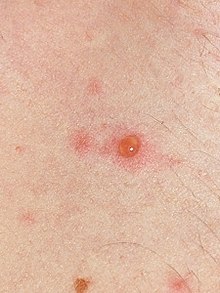An airborne disease is any disease that is caused by pathogens and transmitted through the air. Such diseases include many that are of considerable importance both in human and veterinary medicine. The relevant pathogens may be viruses, bacteria, or fungi, and they may be spread through coughing, sneezing, raising of dust, spraying of liquids, or similar activities likely to generate aerosol particles or droplets. Strictly speaking airborne diseases do not include conditions caused simply by air pollution such as dusts and poisons, though their study and prevention may be related.
Overview

Airborne diseases include any that are caused by pathogens and transmitted through the air. Some are of great medical importance. The pathogens transmitted may be any kind of microbe, and they may be spread in aerosols, dust or liquids. The aerosols might be generated from sources of infection such as the bodily secretions of an infected animal or person, or biological wastes such as accumulate in lofts, caves, garbage and the like. Such infected aerosols may stay suspended in air currents long enough to travel for considerable distances, though the rate of infection decreases sharply with the distance between the source and the organism infected.
Airborne pathogens or allergens often cause inflammation in the nose, throat, sinuses and the lungs. This is caused by the inhalation of these pathogens that affect a person's respiratory system or even the rest of the body. Sinus congestion, coughing and sore throats are examples of inflammation of the upper respiratory air way due to these airborne agents. Air pollution plays a significant role in airborne diseases which is linked to asthma. Pollutants are said to influence lung function by increasing air way inflammation. Alongside pollutants, tobacco smoke increases the risk of attracting these diseases.
Many common infections can spread by airborne transmission at least in some cases, including: Anthrax (inhalational), Chickenpox, Influenza, Measles, Smallpox, Cryptococcosis, and Tuberculosis.
Airborne diseases can also affect non-humans. For example, Newcastle disease is an avian disease that affects many types of domestic poultry worldwide which is transmitted via airborne contamination. Often, airborne pathogens or allergens cause inflammation in the nose, throat, sinuses, and the upper airway lungs. Upper airway inflammation causes coughing congetion,and sore throat. This is caused by the inhalation of these pathogens that affect a person's respiratory system or even the rest of the body. Sinus congestion, coughing and sore throats are examples of inflammation of the upper respiratory air way due to these airborne agents.
Causes
An airborne disease can be caused by exposure to a source: an infected patient or animal, by being transferred from the infected person or animal’s mouth, nose, cut, or needle puncture. People receive the disease through a portal of entry: mouth, nose, cut, or needle puncture.
Prevention

Some ways to prevent airborne diseases include washing hands, using appropriate hand disinfection, getting regular immunizations against diseases believed to be locally present, wearing a respirator and limiting time spent in the presence of any patient likely to be a source of infection. Exposure to a patient or animal with an airborne disease does not guarantee receiving the disease. Because of the changes in host immunity and how much the host was exposed to the particles in the air makes a difference to how the disease affects the body.
With few exceptions, antibiotics are not prescribed for patients to control viral infections. They may however be prescribed to a flu patient for instance, to control or prevent bacterial secondary infections. They also may be used in dealing with air-borne bacterial primary infections, such as pneumonic plague.

